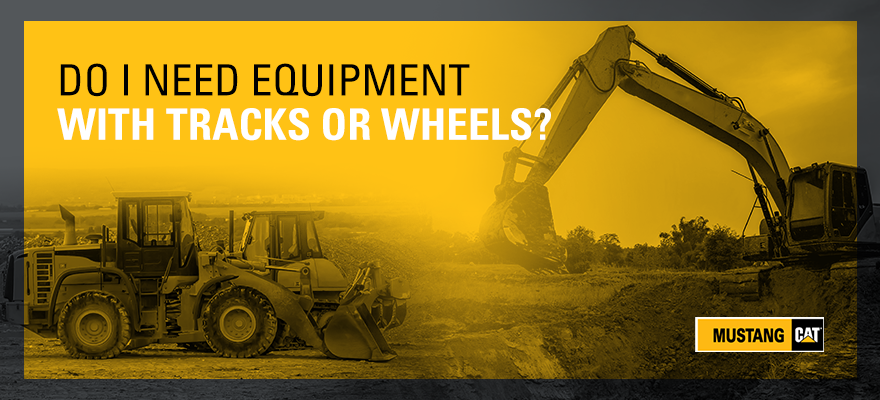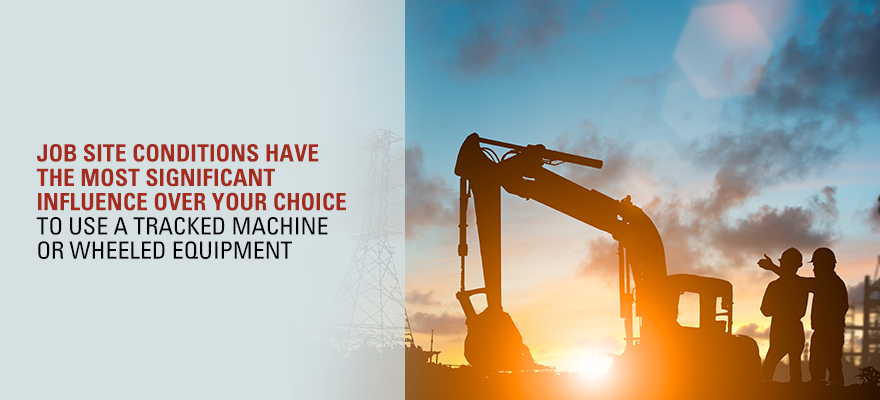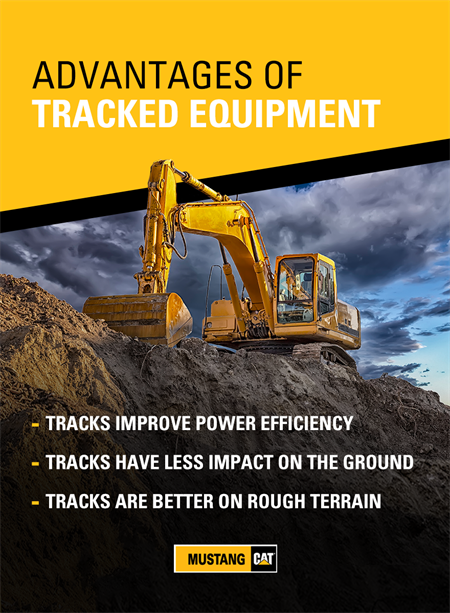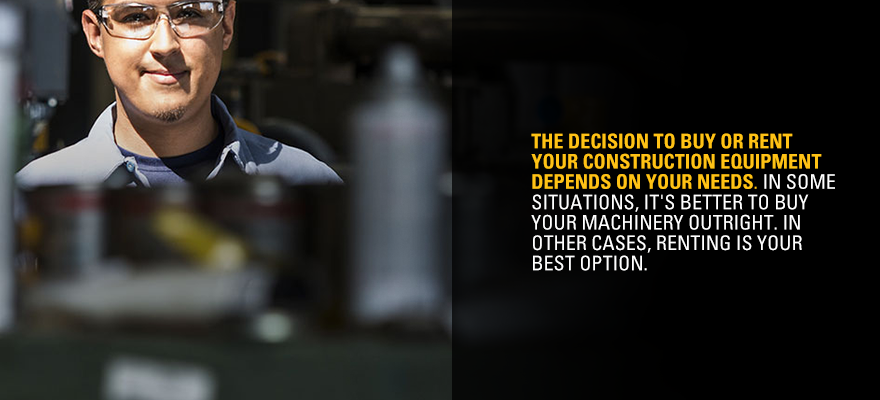Do I Need Equipment With Tracks or Wheels?

If you’re in the market for construction equipment, you’ve no doubt realized that you have a vast array of options. Choosing the right equipment for the job is critical to ensuring productivity and profitability. One of the decisions you’ll face is whether to select equipment that has tracks or wheels.
Your choice between tracks and wheels depends on the application you’re putting your machinery to work in. In the tracks vs. wheels discussion, you have to consider the project in question and weigh considerations like speed, mobility, safety and stability. There isn’t one right solution to the wheeled vs. tracked problem.
The difference between a tracked vehicle and a wheeled vehicle lies in weight distribution. Tracks, by nature of their design, distribute your machine’s weight over a larger area far more efficiently than a similar piece of equipment with wheels. However, tracked machinery tends to move slower and cost more than their wheel-equipped counterparts.
So, whether tracks or tires is the right choice depends on your needs. In some situations, you’re better off with a tracked machine, and in other applications, wheels are your best choice. Let’s take an in-depth look at the differences and which is better — tracks or wheels.
Which Is Better — Tracks or Tires?
Job site conditions have the most significant influence over your choice to use a tracked machine or wheeled equipment. As a rule of thumb, tracks are best suited to soft and loose soil or snow conditions, whereas tires perform better on hard surfaces like asphalt and concrete. Tracks also out-perform wheels on uneven terrain and sloped sites. Wheels, on the other hand, give superior performance on flat and relatively smooth surfaces that are solid enough to support the sharper weight distribution you’ll experience with a wheel-equipped machine.

Traction is a major factor in how tracks and wheels differ. In almost all circumstances, a tracked machine has better traction than construction equipment with wheels. An excellent example of traction is comparing tracks vs. tires in skid steers. Tracks give these highly versatile machines excellent traction in mud and loose sand in comparison to skid steers with wheels, which tend to sink and get stuck in loose surfaces.
Before comparing propulsion and suspension systems, you’ll need to explore the difference between a skid steer and a track loader. The two construction machines appear similar and perform the same tasks, but that’s not so when it comes to traction and working on various surfaces.
True skid steer loaders have rubber tires. They’re four-wheeled machines that steer by braking one side’s wheelset and putting power to the other side. This forces the machine to skid into a turn, and often it revolves within its own radius.
Track loaders have a distinctly different design when it comes to putting power and weight to the ground. Their undercarriage supports tracks mounted on idlers. Tracked loaders also turn by braking one track set and accelerating the other. However, tracked loaders put considerably less weight transfer on their working surface than wheeled skid steers do.
You’ll also hear the term multi-terrain loader. Don’t be confused by thinking it’s another name for a compact track loader. Multi-terrain loaders give even better weight transfer and place lighter point loads on the ground than regular steel-track loaders. The difference is in specialty suspension systems and superior rubber track design.
Skid steers, compact track loaders and multi-terrain loaders aren’t the only equipment in the tracks vs. wheels debate. Larger machines that normally run on tracks like excavators, dozers and track loaders also offer propulsion alternatives. In the Cat® brand of construction equipment, you’ll find great choices of wheel excavators, wheel loaders and wheel dozers.
To fully grasp the differences between tires and tracks, it’s necessary to look at the science behind track and wheel designs. Heavy equipment manufacturers like Cat spend enormous sums researching and developing machinery to perform specific tasks under exacting equipment. Cat engineers realize that weight distribution is a key performance factor, and they use science as their chief design tool.
The Science Behind Tracks and Tires
Cat equipment designers and engineers pay attention to weight transfer principles like point loads and co-efficient of traction. These are critical factors in determining how a machine will perform with live loads and dead loads during machinery operations. Dead loads refer to the machine’s static weight when it’s empty. Live loads are the total weight when the machine is loaded with material.
Totaling live and dead loads are the foundation for calculating point loads and traction co-efficient. These two formulas dictate how well a machine will transfer weight and how it will perform on different surfaces. Here’s an explanation of point loads and coefficient of traction:
- Point loads: Point loads are the actual surface area or the point that tracks and tires touch the ground. This is the machine’s total weight, whether loaded or not, that’s placed upon the point where the tire or track area separates the machine from its surface. This is a gravitational effect, and it’s measured in pounds per square inch or PSI. Mathematically, the smaller the weight transfer area, the larger the point load force will be. For example, a tracked machine has a much greater surface contact area than wheeled equipment. Track point loads are much larger by area but smaller by PSI than wheels. This explains why tracks tend to float over soft surfaces while wheels sink out of sight.
- Traction co-efficient: This scientific principle is different from point loading. Co-efficient of traction is a relationship between the available pull allowed by ground conditions and the downward force or weight exerted by the machine through its point loads. This calculation determines how well the machine grips the ground under the particular condition it’s working on. In other words, it’s how much traction the machine can get. A machine’s traction formula says that the traction co-efficient multiplied by the point load weight equals the pull (P = CE x PSI). Engineers express this measurement in a decimal rating with 0.1 being highly slippery and 1.0 having a great grip on the surface.
Different working surfaces and conditions are a huge factor in how tracks and tires perform. Generally, slippery ground has a much lower traction coefficient than hard and gritty surfaces. You’d think there’d be a direct relationship between tires, track and ground surface that predicts traction performance.
That’s not necessarily true. Tracks don’t always provide better grip than tires. Tire-equipped machines get better traction on hard surfaces like asphalt and concrete than tracked machines do. However, in loose material and slippery surfaces, tracks clearly beat tires in the traction department. This brings us back to the question of whether you need track or tires. Again, it depends on your working environment. You need to look at the advantages of tracked equipment and the advantages of wheeled vehicles when it comes to doing your job. You should also weigh the disadvantages of each propulsion system.
Advantages of Tracked Equipment
The main advantage of track-equipped machinery is the significantly lower point load or weight distribution force exerted on your working surface. The best analogy for track advantages is that they allow your machine to float on top of the surface rather than sinking in like wheeled machines tend to do. Other track-equipped machine advantages include:
- Tracks improve power efficiency. Greater force is placed over a wider area, which results in better power performance.
- Tracks have less impact on the ground. Because of their wide and soft imprint, tracks do less surface damage than wheels.
- Tracks are better on rough terrain. You have greater stability and traction with tracks, which makes them superior performers on rough surfaces and sloped sites.

Disadvantages of Tracked Equipment
While tracks offer some superior advantages over wheeled options, they do have some drawbacks. One of the most significant disadvantages is cost. That’s both in buying track-equipped machinery and maintaining it. Here are three other disadvantages that tracks have:
- Tracks have slower speed than wheels. This can be an important issue when you have to move quickly to make a profit.
- Tracks can damage finished surfaces. Steel tracks can chew up concrete and pavement, which makes them unsuitable for certain jobs.
- Track machines are more difficult to transport than equipment running on tires. Because of the limited speed and damage potential, track machines need trailering from site to site, which takes time and specialized equipment.
Advantages of Wheeled Equipment
There are some situations where you can’t beat wheeled machines. When you need fast motion and high maneuverability, a wheeled machine will out-perform almost everything mounted on tracks, and that’s a real advantage on many sites. Other advantages to wheels are:
- Wheeled machines are less expensive to buy than tracks. Because of suspension complexity and the nature of steel and rubber tracks, there’s a higher cost than working on tires.
- Wheeled machines are less expensive to buy than tracks. Because of suspension complexity and the nature of steel and rubber tracks, there’s a higher cost than working on tires.
- Wheeled machines require less maintenance than tracked ones. From a cost viewpoint, wheels are less expensive to maintain and repair than tracks.
- Wheeled machines are lightweight. Tires weigh less than tracks, and this makes wheel-equipped machines easier to move and operate under certain conditions.
Disadvantages of Wheeled Equipment
Like almost every situation, there are disadvantages associated with buying, renting and operating machines on wheels. The main disadvantage has to be stability. By design, track machines have wide and stable footprints. Wheels have less ground contact, making them less stable than tracks under most conditions. Other disadvantages of wheeled equipment include:
- Wheels get stuck easier than tracks. If you’re operating on soft surfaces such as mud, sand or snow, you’ll get bogged down with wheels far quicker than you would if running on tracks.
- Wheels wear out faster than tracks. This means you’ll replace a lot more tires than tracks.
- Wheels puncture while tracks don’t. Wheel machines can’t perform on sharp rock or in demolition debris the way tracks can without getting a flat.
These are the main pros and cons normally brought up in the tracks vs tires decision. Something else that’s always discussed is whether you’re better off to buy or rent your construction equipment. Regardless of whether you choose tracked machinery or decide on wheeled equipment, you’ll still have to face the rent vs. buy dilemma.
Renting vs. Buying Construction Equipment

Should you buy or rent your construction equipment? Much like the choice between tracks and tires, the decision to buy or rent your construction equipment depends on your needs. In some situations, it’s better to buy your machinery outright. In other cases, renting is your best option. Here are some of the key points to consider when deciding between buying and renting your tracked or wheeled equipment:
- Cash outlay and return on investment: When you buy construction equipment, you’ve purchased a valuable asset that can earn you money by being able to take on specific jobs. However, with renting, you don’t require an immediate and significant cash outlay, allowing you to invest money elsewhere.
- Maintenance: Rental companies look after all maintenance and it’s paid for as part of your rental agreement. Once you own your equipment, you’re responsible for maintaining it and paying all associated costs. However, by following proper maintenance plans, you can protect your investment and ensure a higher resale value.
- Depreciation and resale: All construction equipment depreciates with age and wear. Depreciation costs are built into rentals whereas depreciation becomes a liability in owned machinery. Maintaining your equipment becomes all the more important in retaining value.
- Tax benefits: Both renting and owning construction equipment have tax benefits. Discuss with your accountant how you can write off costs associated with rented or purchased equipment.
- Convenience: Rental equipment is usually readily available, especially when working with a reputable dealer that has an extensive inventory network. However, if you own your machinery, you’ll always have it at your service, and that is a real convenience.
Partner With Mustang Cat for All Your Equipment Purchases and Rentals
Mustang Cat is Southeastern Texas’ leading supplier for all your construction equipment purchase and rental needs. No matter if you’re looking to buy new and used machines or renting a specialty piece for a short-term job, Mustang Cat has what you’re looking for. That includes an excellent lineup of track and wheel-equipped machines.
At Mustang Cat, our equipment experts can help you decide whether your project needs wheeled or tracked equipment. For information on how Mustang Cat can help you, call us today at 1-800-256-1001 or contact us online.



